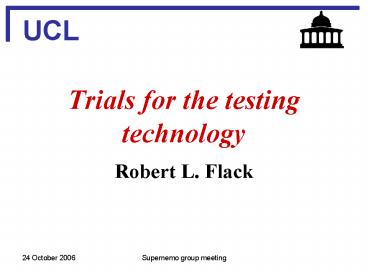Trials for the testing technology PowerPoint PPT Presentation
Title: Trials for the testing technology
1
Trials for the testing technology
UCL
- Robert L. Flack
2
(No Transcript)
3
Test cell
- The cell has to have a full complement of wires.
- Need to be able to remove and replace all of the
wires, hence also want spares. - Require five ports for lenses.
- Require holes next to each port to insert fibre
optic. - The length has to be four metres, or whatever the
agreed length is to be used in Supernemo.
4
Purpose and basis of the trials
- First purpose of the trials is to find the best
and most efficient method for triggering the
plasma for our final testing procedure. - Secondly to trial the best combination of
cleaning methods. - Thirdly to build experience with these various
techniques. - The proposed method of comparing one technique
against another is to run each trial many times
and record the size of the pulse from the plasma.
The heights of these pulses should fit a
Gaussian. The values of the mean and width for
each trial will be compared. - Another factor could be the quality of the shape
of the pulse.
5
Triggering the plasma
- Obtain propagation of the plasma with cosmic
rays. Separate these into triggers from the five
regions of the anode wire. - Demonstrate triggering of the plasma with the
UV-laser from the same five regions. - Use lenses with different focal lengths to test
triggering at different depths in the cell
between anode and cathode. - Demonstrate triggering using optical fibre rather
than a lens.
6
Cleaning the wires with heptane
- The purpose of the tests on various cleaning
methods is to try and judge what is the best
combination to obtain the largest average pulse. - Use unclean wire or deliberately contaminate the
anode and see if the position of the
contamination can be found. - Try heptane to clean it.
- Will this be sufficient?
- Try alternatives to heptane to judge their
effectiveness.
7
Test the baking technique
- Build an oven and trial the baking technique.
- The nemo3 TDR reported using a temperature of
650oC. - Bake contaminated wire and see if this will be
sufficient without first cleaning with heptane. - Try cleaning with heptane and then baking it and
again.
8
Nitrogen jet
- Blow a jet of nitrogen along the length of a
contaminated anode wire and test to see if it
will propagate a plasma. - Then take wire cleaned with heptane but will not
support a plasma and see if this technique will
cure the problem. - Then take wire that has been both cleaned with
heptane and baked.
9
Testing the tension on the wire
- As a separate problem the best method of
measuring the tension of the wire during
construction and in situ. - During the wiring process a mechanical method is
probably best. - In situ an electrical method will be trialed.
- These have yet to be finalised.
10
Conclusion
- Need a clean environment to do these trials.
- Many and varied trials to be done and will take a
lot of time. Need to get started! - Need to finalise the methods for measuring the
tension on the wires. - Could also start preparing the ground for
automatic electronic readout. - I will document the trials for circulation and
will be placed on my website.

